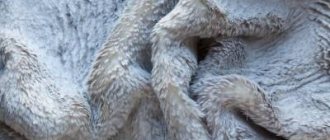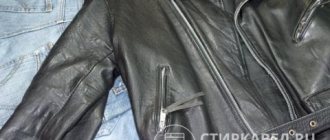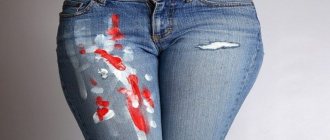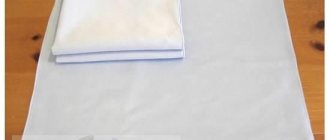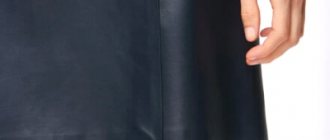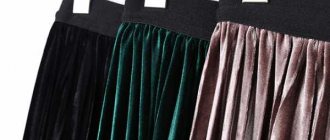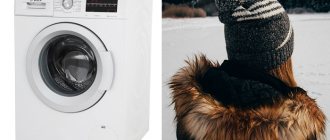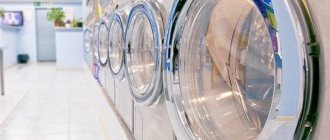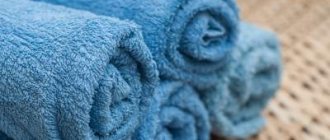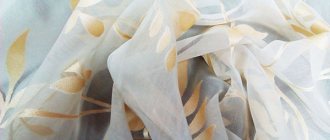Features of pleated fabrics
It's no secret that pleated skirts are most often made from delicate materials, such as chiffon or satin. Less often - from knitwear, wool, denim or leather. Some materials are too susceptible to washing and ironing, so women do not risk buying such clothes.
To preserve the beauty of the product, simply read the label on the inside seam and follow the care recommendations indicated there. If there is no information on the tag that the fabric can withstand dry cleaning only, then the skirt can be washed. This can be done either by hand or in an automatic machine, but only by adhering to the rules for processing pleated products.
Rules for caring for pleated products
The “accordion” effect is created on almost any fabric, so it is necessary to take into account the fact that depending on the material, care for a pleated skirt differs. But there are also general rules that should be followed.
- Pleated chiffon, most often, does not wrinkle and easily returns to its original shape if hung evenly.
- But pleated dresses made of polyester and thick satin will have to be ironed. It’s better to start when the skirt is not yet completely dry and the folds more easily take on their original shape.
- Knitted pleated skirts are ironed only through several layers of gauze. The same applies to woolen items.
- Silk pleated skirts rarely need ironing, but there are exceptions. In this case, the semi-dry product is turned inside out and the iron is carefully passed through the folds. It is not recommended to splash water on silk as it will leave stains.
- It is worth ironing chiffon less often, as it is capricious and does not tolerate high temperatures.
- There is no need to fold pleated clothes in the closet, because such storage will ruin their appearance. The skirt is hung on hangers and care is taken that the row is not too tight.
AdviceBefore you start washing or ironing, be sure to read the labels, which contain all the necessary care information. If your skirt or dress has a lining, iron it separately.
You don't need to use an iron to straighten a pleated skirt. A more gentle method is vertical steaming. This is done using the appropriate function on the iron, a special device, or using a hot bath.
How to steam a skirt without a steam generator:
- Fill a bath full of hot water and let the steam fill the room.
- Hang the skirt over the container and leave for 10-15 minutes.
- Move the hanger with the item into the room or onto a shaded balcony to allow the item to dry.
How to prepare an item for washing
To prevent the pleated skirt from losing its original shape, prepare for washing in advance. For this:
- Choose the right detergent for the fabric type of the item.
- Before you start washing, carefully fold the skirt along the folds and place it in a laundry bag or regular nylon stocking.
- To better preserve the folds, sew them with white thread. This can be done with small stitches along the bottom of the product or along each fold. The thread should not tighten the material, but should hold loosely.
If you ignore these recommendations, the folds on your clothes may lose their correct shape during washing.
What types of pleated skirts are there?
Ruffled skirt. And this is not surprising, because it not only conquered the world’s catwalks, but also became part of the basic wardrobe. You can combine pleated fabric with almost anything. Voluminous sweaters, jackets, shirts, sneakers and high boots - all this looks stylish in combination with flowing chiffon.
And pleated not for office or school clothes made of fine wool, acrylic or polyester - a classic that never loses its relevance.
Advice For school uniforms, choose thin woolen fabric containing acrylic, viscose, polyamide or silk, no more than 50%. Polyester is stuffy and only suitable for skirts. Sundresses and trousers made of this material will make you feel stuffy in the classroom and cold outside.
The pleats on the pleated fabric can be either pronounced or slightly noticeable. Styles are classified by length, but a skirt below the knee is considered relevant. Designers enhance the accent and decorate models with belts, embroidery, unusual patterns and rhinestones. The material can also be very different: from chiffon and polyester to eco-leather.
How to wash a pleated skirt by hand
The pleated skirt can be safely washed by hand. The main thing is to follow the prescribed recommendations for processing products with folds.
Hand washing rules:
- wash in non-hot water at a temperature not exceeding 30 degrees;
- give preference to gels rather than powders, since the latter do not dissolve well in cold water and can leave streaks;
- Before washing, soak the product in soapy water for 10–60 minutes, depending on the persistence of the stains;
- try not to twist or rub the material too much during washing;
- rinse the wardrobe item in at least three waters;
- do not wring out the item, but simply hang it over a bathtub or other container and let the water drain.
To maintain the lightness of the product, add a little fabric softener to the rinse water.
Preventing the appearance of folds and creases
To ensure that the veil does not lose its beautiful appearance before the bride shines in front of the groom and her closest people, you need to follow some recommendations. Direct ironing alone will not be enough to ensure that the veil retains its appearance until the wedding. You need to learn how to store it correctly. Simply putting it in a closet with other things is not a suitable option. This way the veil will become unusable, and creases and folds will appear on it again, which are difficult to remove. Several ways have been developed to preserve an ironed veil until the wedding:
- covers for a wedding dress - if space allows, the veil is placed in a cover for the dress, so it will retain its freshness;
- special case - for a decorative veil of a large size or with a lot of beautiful additional details, a case is made separately;
- homemade bag - great if you have a sewing machine in the house - you can sew the cover yourself in a few minutes in the manner of a regular duvet cover, but smaller in size; in extreme cases, use plastic storage bags.
Only completely dry items are placed in bags or cases. If you put something wet inside, it is more likely to wrinkle.
How to machine wash
Automatic washing of such products is not prohibited. The main thing is to follow the standard rules for processing such clothing, namely:
- for washing, choose only the delicate cycle;
- give preference to liquid powders that dissolve well and wash even in cold water;
- set the machine to a minimum temperature setting not exceeding 30 degrees;
- if available, turn on the additional rinse program;
- turn off the spin mode;
- hang the product over the container on a hanger, allowing the water to drain, and then dry it.
To preserve the attractive appearance of the folds of a pleated skirt, store and care for the product correctly.
Washing polyester items
Polyester is 100% synthetic material. Pleated polyester items can be washed either by hand or in a machine. At the same time, follow the basic rule for washing such products - set the delicate cycle and do not exceed the water temperature above 30 degrees. Before washing, it is better to turn the item of clothing inside out.
Iron the item only with the iron set to the “silk” setting, or use an additionally damp cloth. In this case, just like before washing, turn the product inside out.
Options for different body types
The sun flared cut was initially used as the style of skirts, but over time, designers proved that pleating looks great on other varieties:
- A-line - ideal for the “inverted triangle” figure, since it fits at the waist and widens downward. This visually adds volume to the hips. In addition, medium-length models visually lengthen the legs and make a few extra centimeters on the buttocks invisible.
- The pencil is a very feminine, but at the same time “demanding” model. Repeating the curves of the figure, it emphasizes the lines of the waist and hips. Pencil skirts made of corrugated materials can be recommended for slender girls with hourglass and rectangle body types, but even they should not wear a similar style if they cannot boast of perfectly straight legs and beautiful calves.
- The half-sun cut is suitable for any body type. It will help hide a wide pelvis for those with a pear shape and, conversely, will add volume to those with a T-shaped physique. An important point is that the choice of length of a ruffled semi-sun skirt is determined by the woman’s height. An individual silhouette can also be selected for overweight ladies, but only if they are tall.
- The sun is a traditional cut for pleated skirts made of lightweight materials. Such products will fit perfectly on both narrow and curvy hips, but in the latter case, the desired condition is a pronounced waist. The corrugated folds that beautifully fly apart when moving will emphasize it even more.
- With elastic - models for slim people. In this case, the corrugation visually lengthens the figure even more (if the elastic is tight and wide), especially if the top of the outfit is chosen correctly.
The asymmetrical cut of ruffled skirts is considered the most stylish, and with the right choice of shade and style, such models are suitable for both young girls and mature women
However, since such a thing definitely attracts attention, it is desirable that its owner can boast of slender legs
General rules for selecting ruffled skirts:
- the fragility of the figure will be emphasized by the combination of large and small folds in one product;
- both pleated and corrugated models made of lightweight fabrics will add volume and make the silhouette more proportional;
- those whom nature has endowed with curvy hips should not wear weightless, corrugated knee-length models. The best option would be a midi or maxi skirt made of thick fabric with large pleats. In particular, a ruffled model with a smooth yoke will help add a slim waist and hips.
Pencil
With elastic band
half sun
Sun
Trapezoid
Tips for washing chiffon pleated skirts
It is better to wash a chiffon pleated skirt by hand. At the same time, choose special detergents for delicate fabrics. Use only non-hot water, with a temperature not exceeding 30 degrees. It is unacceptable to shake or twist chiffon items intensively. If you still prefer machine washing, then for processing items, choose only the delicate mode without spinning and drying.
You can iron the skirt only after thoroughly drying it at a set temperature on the iron from 60 to 120 degrees or by turning on the “silk” function on the thermostat. There is no need to wet the material. To ensure safe handling, place gauze or cloth under the iron. After ironing, allow the item to cool for 10-15 minutes.
Can pleated fabric be bleached?
Since pleated skirts are most often made from delicate materials, use bleaches and stain removers with extreme caution. Otherwise, you may damage the fabric, causing holes to appear on the product or colors to fade greatly. Do not use chlorine bleaches. It is better to give preference to products that work with active oxygen.
If you prefer to use improvised means for whitening, choose the most gentle ones, for example, aspirin or hydrogen peroxide. Mix several liters of water and a teaspoon of peroxide in a container. Dip a wardrobe item into the composition and leave to act for 15-20 minutes. Turn the item over every 5-7 minutes. After treatment, wash the product using the usual method.
Stain removal and whitening
The use of bleaches is only possible if there is a corresponding symbol on the product label. Chlorine-containing products can cause irreparable harm to colored items, as well as skirts made of chiffon, silk, and wool.
Stains and complex dirt from a pleated skirt must be removed immediately after they appear.
Fat
A fresh grease stain needs:
- Cover with talcum powder, baking soda, starch, and baby powder. After absorption, gently shake off.
- If there is a trace left, fill it again.
- Wash in any way.
Difficult stains should be carefully treated with dishwashing detergent:
- Apply a few drops to the damaged area.
- Leave for 20–30 minutes.
- Rinse under warm water. Wash the skirt completely.
Blood
Fresh drops needed:
- blot with a napkin soaked in hydrogen peroxide or lemon juice;
- leave for 5–7 minutes;
- rinse with cool water.
You can apply a paste of baking soda and vinegar to dry stains.
Tea, coffee, wine
Drink stains can be removed:
- Citric acid solution (1 tsp per 100 ml): pour onto the damaged area, leave for 20 minutes. The product is effective against stains from red, white wine, juices, compotes.
- Table vinegar (9%): moisten a napkin and blot away any drops of tea or coffee.
- Glycerin with vodka (1:3): apply to traces of champagne or wine, leave for 15 minutes, rinse under running water.
After removing stains, the item must be washed completely in cool water.
Lipstick, cosmetics
Traces of cosmetic products can be removed with medical alcohol:
- apply to a cotton pad;
- Gently blot the stain from the inside out, after placing a clean napkin or paper towel on the front side.
Similarly, you can use vodka or ammonia.
Ink
Ink can be removed from white items with a solution of hydrogen peroxide and ammonia (1:1).
A universal remedy for any stains is ordinary laundry soap . It should be applied liberally to the contaminated area and left for 10–60 minutes (depending on the complexity of the damage). Then rinse the clothes thoroughly and wash them in any way.
When choosing a stain remover, you need to take into account the material from which the item is made, as well as its color. When in doubt, it is better to use delicate store-bought stain removers.
To remove a ballpoint pen stain:
- Apply lemon or onion juice to the damaged area.
- After 15–20 minutes, rinse with running water.
- Wash by hand or in a washing machine.
How to restore wrinkles after washing
If for some reason the pleats on the skirt disappear, do not despair. You can still restore them. This can be done in several ways:
- Soap. From the inside out, rub the folds with a bar of soap. Place the folds next to each other and iron thoroughly with a hot iron.
- A special solution with egg white. Dissolve laundry soap shavings in warm water. Add egg white, a handful of starch and a tablespoon of vinegar to the soap solution. Soak a cotton cloth in the solution and iron the skirt through it. To prevent liquid from sticking to the iron, place a sheet of paper on top.
- Gelatin-based fixation solution. Mix a solution of laundry soap with 1 tbsp in a container. spoon of gelatin. Moisten the material with the substance and carefully iron it through gauze or paper.
- Vinegar with water. Mix the ingredients in equal proportions. Moisten all the folds of the skirt and iron through paper or gauze.
If the product is made of delicate fabric, you cannot use an iron. Use a steamer to restore wrinkles.
How to iron a pleated skirt and dress, keeping the wrinkles intact
15 Feb 2018
Comments: No
Light skirts and dresses made of corrugated fabric have recently become particularly popular, and this is quite justified: they look elegant and are ideal for warm days and special occasions. And pleated skirts made of thick material are also part of the classic school uniform for girls. But when it comes to the need to iron such a thing, many are confused: how to iron a pleated skirt if it has dozens of small folds? Meanwhile, there are several simple and proven ways to easily put such clothes in order.
How to dry pleated items correctly
Take drying your pleated skirt just as seriously as washing it. There are several ways to dry a product:
- Simply hang the item on clothes hangers and dry naturally.
- Dry the skirt by placing it in a stocking or laundry bag before washing.
- Roll the wardrobe piece into a tube and tie it with thread on your belt, hang it up and dry completely.
Such manipulations will allow you to preserve the folds of the product without ironing.
Preparing for ironing
The pleated skirt must be initially prepared for this procedure - carefully wash it and dry it
Proper washing
Initially, you will need to read the information on the label about the type of fabric and care options for it. Pleated clothing is generally made from jersey or chiffon, for which hand washing using gentle detergents is more suitable. This does not mean that the product cannot be washed in a washing machine. Modern technology is equipped with functions for washing delicate items, which include pleated items.
To wash by hand, you need to make a solution using detergent. It must match the type of fabric from which the product is made. The skirt is pre-soaked if it is very dirty. You can wash the product immediately if you just need to freshen it up. You will need to immerse it in water, do not rub it, do not squeeze it, wash it with smooth movements by lifting it up and down.
It is important to properly prepare your pleated skirt for washing. The folds are neatly folded towards each other, stitched in a circle
This allows the product to retain its shape. The bottom is also fixed using large stitches in one thread.
How and with what you can dye your trousers blue with your own hands at home
If the product is washed in the washing machine, in addition to marking the folds, you need to place it in a special mesh or bag intended for washing, and immerse it in the drum.
Drying on hangers
A pleated skirt needs to be dried properly, using a hanger for this. Before doing this, you will need to shake it and straighten out the folds. To prevent the product from creasing so much, you only need to hang the slightly wrung out item on hangers.
Rules and recommendations for care
To ensure that your pleated skirt does not lose its original appearance for a long time, take care of it, following all the prescribed rules. For this:
- Be sure to study the label on the item;
- do not neglect the washing temperature;
- dry your skirt only on hangers;
- iron in a mode suitable for the material.
A pleated skirt is a stylish wardrobe item that can easily be ruined if you neglect the rules of care, washing and drying of such products. For maximum safety of the item, wash and iron your pleated skirt only at a suitable temperature.
How to stroke?
If dried properly, chiffon and silk skirts will not need to be ironed. The fabric will stretch and expand under its own weight.
Skirts made from heavier materials are ironed using the lowest possible heat from the iron. Each section is carefully worked out, moving along the folds .
Synthetics are ironed from the wrong side, placing gauze, thin fabric or a special mesh for ironing.
There should be no creases or marks left from the iron . When ironing pleated clothing, you must carefully monitor the formation of clear folds, without displacement.
Place a crumpled leather or denim skirt in the bathroom over a basin of boiling water, close the door tightly and leave for 30–60 minutes. Steam easily smoothes the material without damaging the pleated folds.
Read more about how best to iron a pleated skirt in our separate article.
